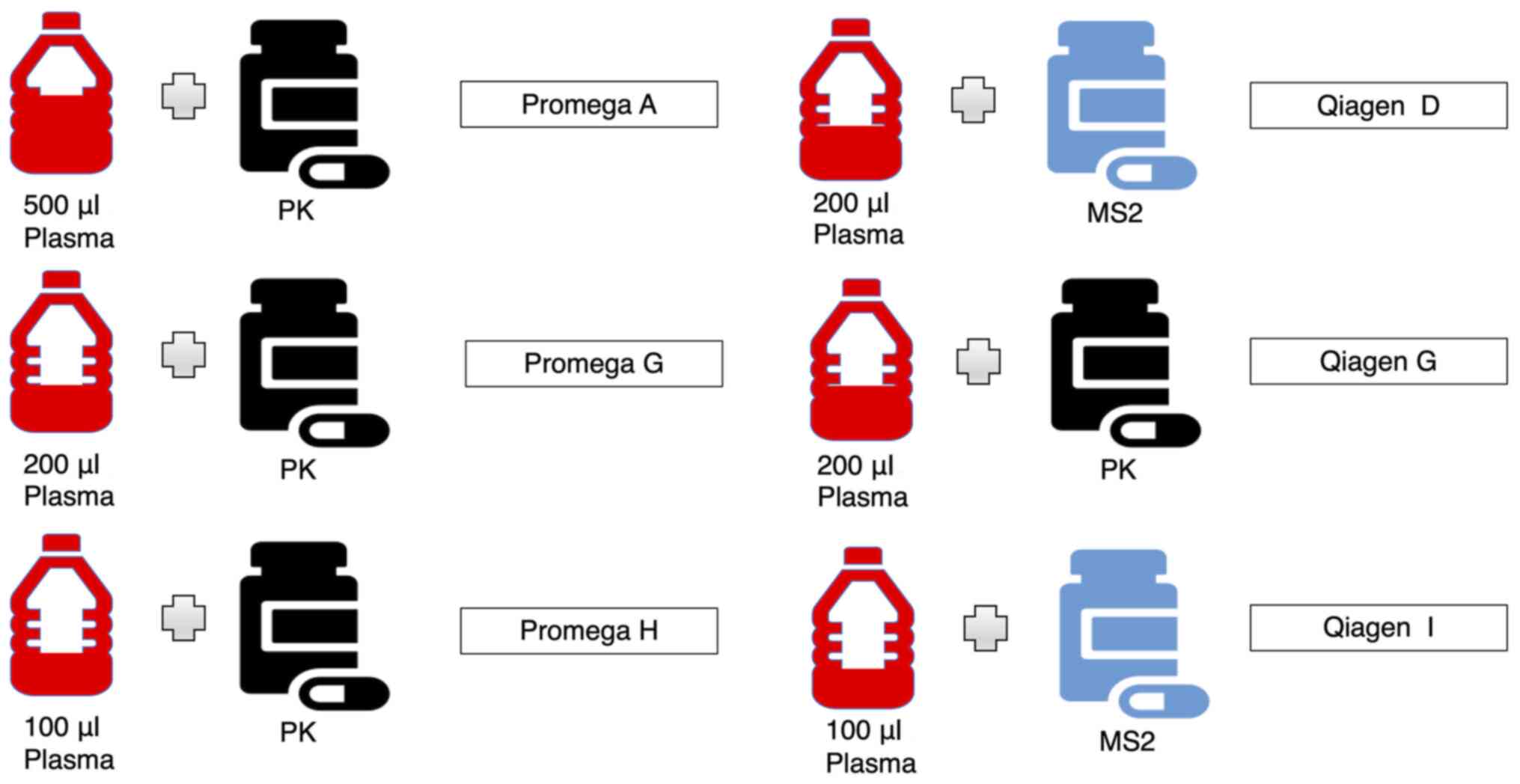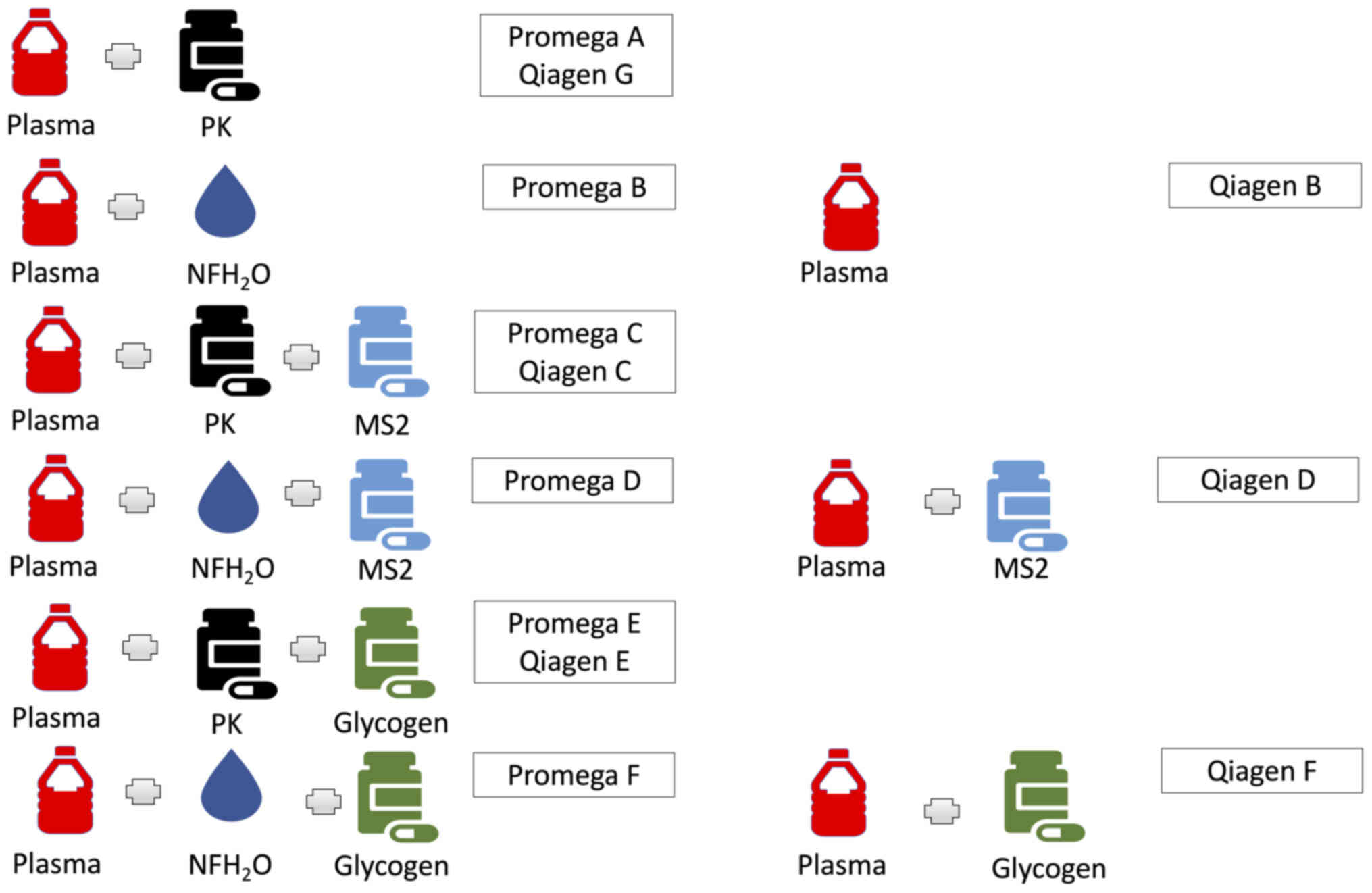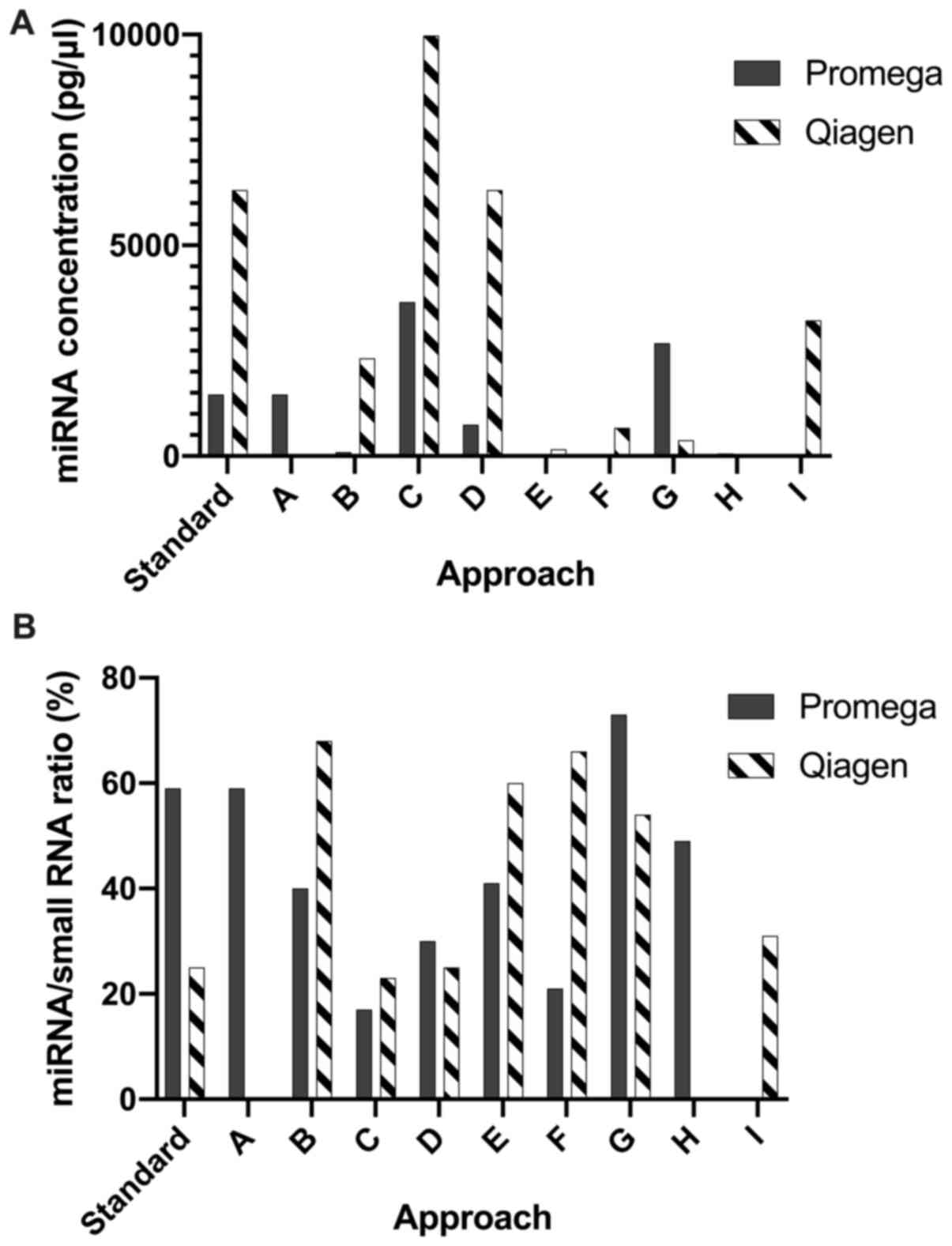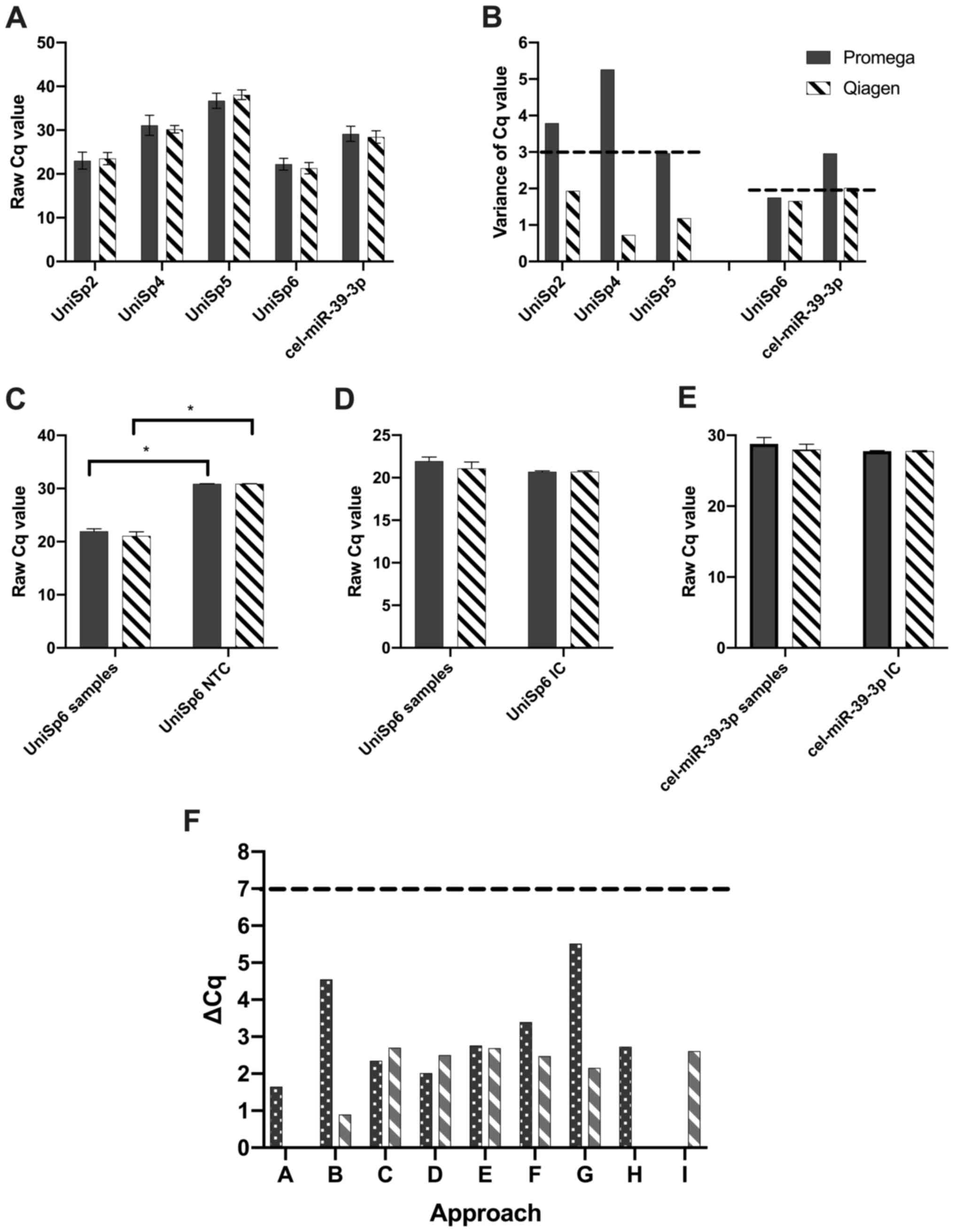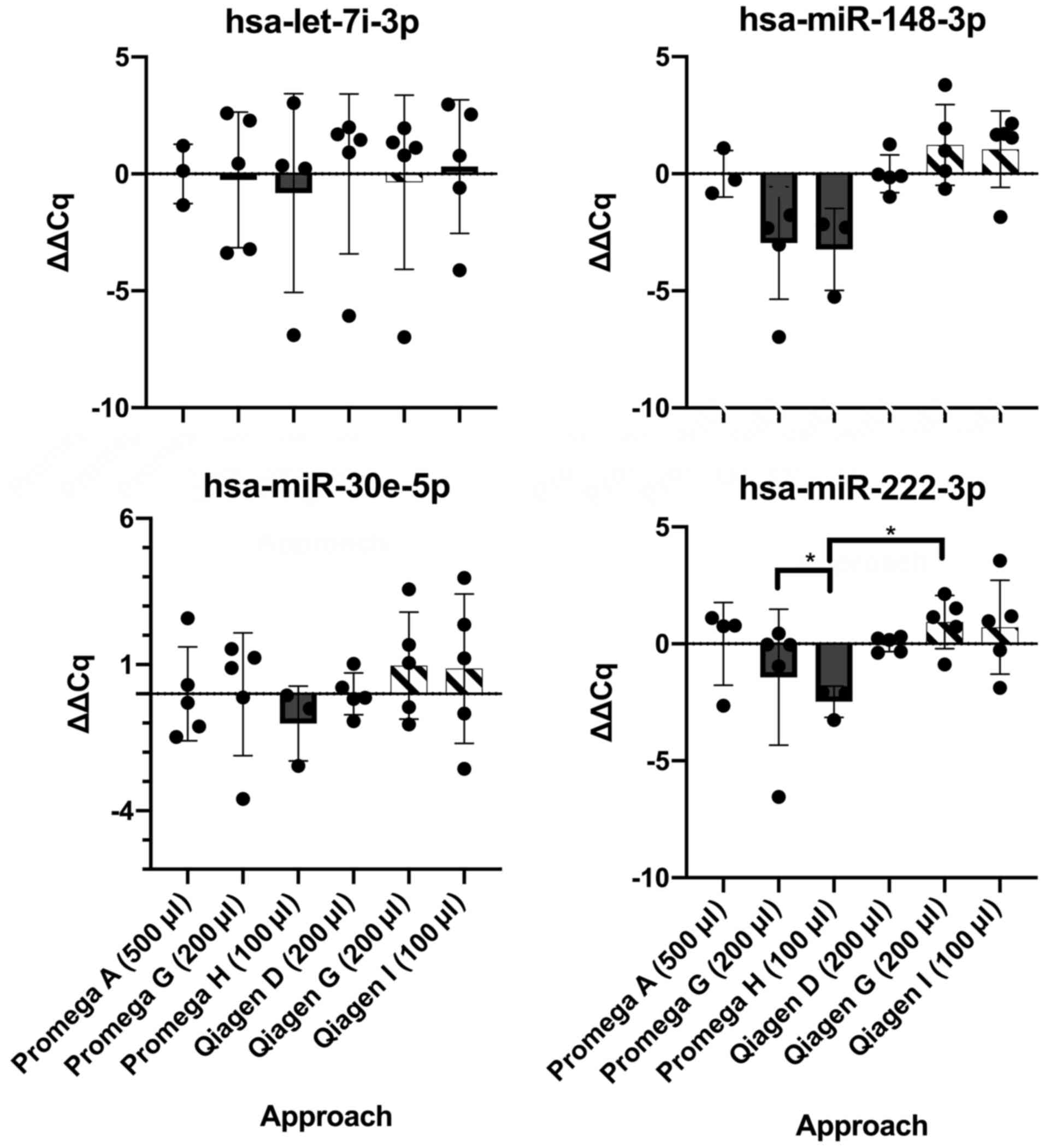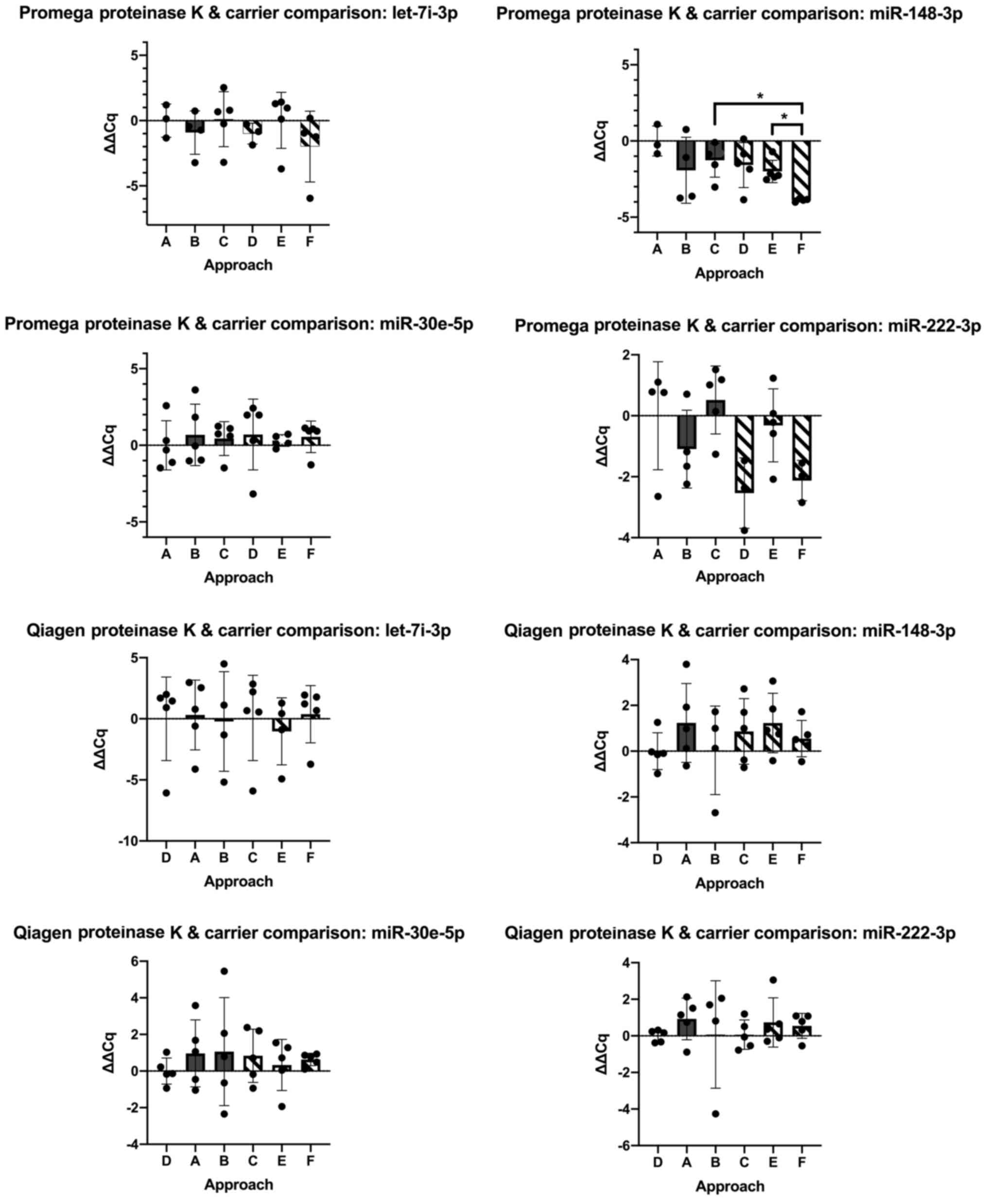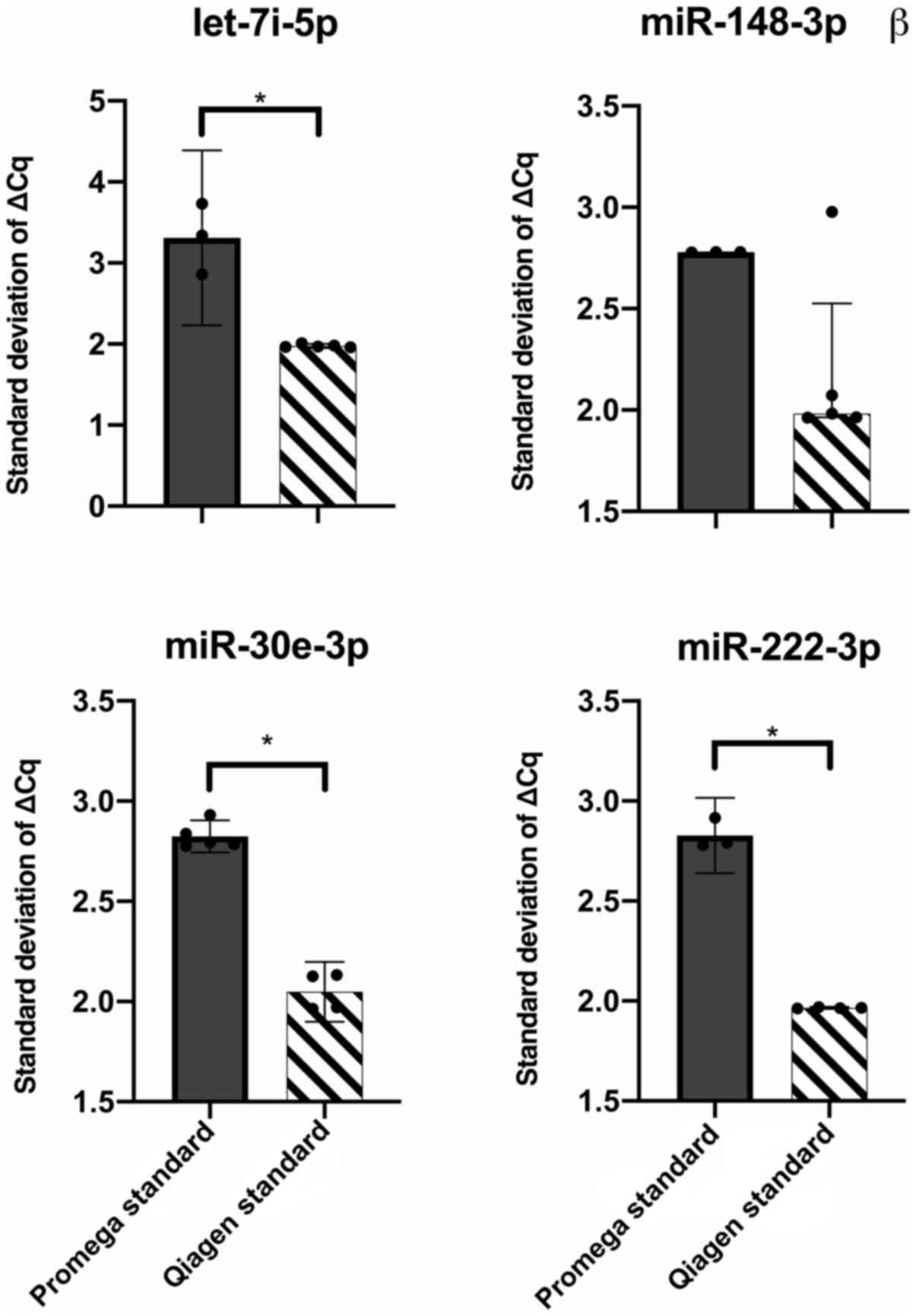|
1
|
Hobert O: Gene regulation by transcription
factors and microRNAs. Science. 319:1785–1786. 2008. View Article : Google Scholar : PubMed/NCBI
|
|
2
|
Croce CM and Calin GA: miRNAs, cancer, and
stem cell division. Cell. 122:6–7. 2005. View Article : Google Scholar : PubMed/NCBI
|
|
3
|
Hammond SM: An overview of microRNAs. Adv
Drug Deliv Rev. 87:3–14. 2015. View Article : Google Scholar : PubMed/NCBI
|
|
4
|
He L, Thomson JM, Hemann MT,
Hernando-Monge E, Mu D, Goodson S, Powers S, Cordon-Cardo C, Lowe
SW, Hannon GJ, et al: A microRNA polycistron as a potential human
oncogene. Nature. 435:828–833. 2005. View Article : Google Scholar : PubMed/NCBI
|
|
5
|
Alrob OA, Khatib S and Naser SA: MicroRNAs
33, 122, and 208: A potential novel targets in the treatment of
obesity, diabetes, and heart-related diseases. J Physiol Biochem.
73:307–314. 2017. View Article : Google Scholar : PubMed/NCBI
|
|
6
|
Creemers EE, Tijsen AJ and Pinto YM:
Circulating microRNAs: Novel biomarkers and extracellular
communicators in cardiovascular disease? Circ Res. 110:483–495.
2012. View Article : Google Scholar : PubMed/NCBI
|
|
7
|
Chen X, Ba Y, Ma L, Cai X, Yin Y, Wang K,
Guo J, Zhang Y, Chen J, Guo X, et al: Characterization of microRNAs
in serum: A novel class of biomarkers for diagnosis of cancer and
other diseases. Cell Res. 18:997–1006. 2008. View Article : Google Scholar : PubMed/NCBI
|
|
8
|
Fayyad-Kazan H, Bitar N, Najar M, Lewalle
P, Fayyad-Kazan M, Badran R, Hamade E, Daher A, Hussein N, ElDirani
R, et al: Circulating miR-150 and miR-342 in plasma are novel
potential biomarkers for acute myeloid leukemia. J Transl Med.
11:312013. View Article : Google Scholar : PubMed/NCBI
|
|
9
|
Rossbach M: Therapeutic implications of
microRNAs in human cancer. J Nucleic Acids Investig. Feb
2–2011.(Epub ahead of print). doi: 10.4081/jnai.2011.2200.
View Article : Google Scholar
|
|
10
|
Mishra PJ: MicroRNAs as promising
biomarkers in cancer diagnostics. Biomark Res. 2:192014. View Article : Google Scholar : PubMed/NCBI
|
|
11
|
Cai M, Kolluru GK and Ahmed A: Small
molecule, big prospects: MicroRNA in pregnancy and its
complications. J Pregnancy. 2017:69727322017. View Article : Google Scholar : PubMed/NCBI
|
|
12
|
Morales-Prieto DM, Ospina-Prieto S,
Chaiwangyen W, Schoenleben M and Markert UR: Pregnancy-associated
miRNA-clusters. J Reprod Immunol. 97:51–61. 2013. View Article : Google Scholar : PubMed/NCBI
|
|
13
|
Morales Prieto DM and Markert UR:
MicroRNAs in pregnancy. J Reprod Immunol. 88:106–111. 2011.
View Article : Google Scholar : PubMed/NCBI
|
|
14
|
Gilad S, Meiri E, Yogev Y, Benjamin S,
Lebanony D, Yerushalmi N, Benjamin H, Kushnir M, Cholakh H, Melamed
N, et al: Serum microRNAs are promising novel biomarkers. PLoS One.
3:e31482008. View Article : Google Scholar : PubMed/NCBI
|
|
15
|
Kotlabova K, Doucha J and Hromadnikova I:
Placental-specific microRNA in maternal circulation -
identification of appropriate pregnancy-associated microRNAs with
diagnostic potential. J Reprod Immunol. 89:185–191. 2011.
View Article : Google Scholar : PubMed/NCBI
|
|
16
|
Chim SS, Shing TK, Hung EC, Leung TY, Lau
TK, Chiu RW and Lo YM: Detection and characterization of placental
microRNAs in maternal plasma. Clin Chem. 54:482–490. 2008.
View Article : Google Scholar : PubMed/NCBI
|
|
17
|
Hromadnikova I, Kotlabova K, Ivankova K,
Vedmetskaya Y and Krofta L: Profiling of cardiovascular and
cerebrovascular disease associated microRNA expression in umbilical
cord blood in gestational hypertension, preeclampsia and fetal
growth restriction. Int J Cardiol. 249:402–409. 2017. View Article : Google Scholar : PubMed/NCBI
|
|
18
|
Hromadnikova I, Dvorakova L, Kotlabova K
and Krofta L: The Prediction of gestational hypertension,
preeclampsia and fetal growth restriction via the first trimester
screening of plasma exosomal C19MC microRNAs. Int J Mol Sci.
20:29722019. View Article : Google Scholar
|
|
19
|
Sheikh AM, Small HY, Currie G and Delles
C: Systematic review of micro-RNA expression in pre-eclampsia
identifies a number of common pathways associated with the disease.
PLoS One. 11:e01608082016. View Article : Google Scholar : PubMed/NCBI
|
|
20
|
Zhu Y, Tian F, Li H, Zhou Y, Lu J and Ge
Q: Profiling maternal plasma microRNA expression in early pregnancy
to predict gestational diabetes mellitus. Int J Gynaecol Obstet.
130:49–53. 2015. View Article : Google Scholar : PubMed/NCBI
|
|
21
|
Zhao C, Dong J, Jiang T, Shi Z, Yu B, Zhu
Y, Chen D, Xu J, Huo R, Dai J, et al: Early second-trimester serum
miRNA profiling predicts gestational diabetes mellitus. PLoS One.
6:e239252011. View Article : Google Scholar : PubMed/NCBI
|
|
22
|
Yu Z, Han S, Hu P, Zhu C, Wang X, Qian L
and Guo X: Potential role of maternal serum microRNAs as a
biomarker for fetal congenital heart defects. Med Hypotheses.
76:424–426. 2011. View Article : Google Scholar : PubMed/NCBI
|
|
23
|
Blondal T, Jensby Nielsen S, Baker A,
Andreasen D, Mouritzen P, Wrang Teilum M and Dahlsveen IK:
Assessing sample and miRNA profile quality in serum and plasma or
other biofluids. Methods. 59:S1–S6. 2013. View Article : Google Scholar : PubMed/NCBI
|
|
24
|
McAlexander MA, Phillips MJ and Witwer KW:
Comparison of methods for miRNA extraction from plasma and
quantitative recovery of RNA from cerebrospinal fluid. Front Genet.
4:832013. View Article : Google Scholar : PubMed/NCBI
|
|
25
|
Ge Q, Shen Y, Tian F, Lu J, Bai Y and Lu
Z: Profiling circulating microRNAs in maternal serum and plasma.
Mol Med Rep. 12:3323–3330. 2015. View Article : Google Scholar : PubMed/NCBI
|
|
26
|
Glinge C, Clauss S, Boddum K, Jabbari R,
Jabbari J, Risgaard B, Tomsits P, Hildebrand B, Kääb S, Wakili R,
et al: Stability of circulating blood-based MicroRNAs -
pre-analytic methodological considerations. PLoS One.
12:e01679692017. View Article : Google Scholar : PubMed/NCBI
|
|
27
|
Brunet-Vega A, Pericay C, Quílez ME,
Ramírez-Lázaro MJ, Calvet X and Lario S: Variability in microRNA
recovery from plasma: Comparison of five commercial kits. Anal
Biochem. 488:28–35. 2015. View Article : Google Scholar : PubMed/NCBI
|
|
28
|
Avissar-Whiting M, Veiga KR, Uhl KM,
Maccani MA, Gagne LA, Moen EL and Marsit CJ: Bisphenol A exposure
leads to specific microRNA alterations in placental cells. Reprod
Toxicol. 29:401–406. 2010. View Article : Google Scholar : PubMed/NCBI
|
|
29
|
Maccani MA, Avissar-Whiting M, Banister
CE, McGonnigal B, Padbury JF and Marsit CJ: Maternal cigarette
smoking during pregnancy is associated with downregulation of
miR-16, miR-21, and miR-146a in the placenta. Epigenetics.
5:583–589. 2010. View Article : Google Scholar : PubMed/NCBI
|
|
30
|
Wang K, Yuan Y, Cho JH, McClarty S, Baxter
D and Galas DJ: Comparing the MicroRNA spectrum between serum and
plasma. PLoS One. 7:e415612012. View Article : Google Scholar : PubMed/NCBI
|
|
31
|
Ban E, Chae DK, Yoo YS and Song EJ: An
improvement of miRNA extraction efficiency in human plasma. Anal
Bioanal Chem. 409:6397–6404. 2017. View Article : Google Scholar : PubMed/NCBI
|
|
32
|
Tiberio P, Callari M, Angeloni V, Daidone
MG and Appierto V: Challenges in using circulating miRNAs as cancer
biomarkers. BioMed Res Int. 2015:7314792015. View Article : Google Scholar : PubMed/NCBI
|
|
33
|
McDonald JS, Milosevic D, Reddi HV, Grebe
SK and Algeciras-Schimnich A: Analysis of circulating microRNA:
Preanalytical and analytical challenges. Clin Chem. 57:833–840.
2011. View Article : Google Scholar : PubMed/NCBI
|
|
34
|
Feng X, Liu Y and Wan N: Plasma microRNA
detection standardization test. J Clin Lab Anal. 34:e230582020.
View Article : Google Scholar : PubMed/NCBI
|
|
35
|
Foye C, Yan IK, David W, Shukla N,
Habboush Y, Chase L, Ryland K, Kesari V and Patel T: Comparison of
miRNA quantitation by Nanostring in serum and plasma samples. PLoS
One. 12:e01891652017. View Article : Google Scholar : PubMed/NCBI
|
|
36
|
Moldovan L, Batte KE, Trgovcich J, Wisler
J, Marsh CB and Piper M: Methodological challenges in utilizing
miRNAs as circulating biomarkers. J Cell Mol Med. 18:371–390. 2014.
View Article : Google Scholar : PubMed/NCBI
|
|
37
|
Kloten V, Neumann MHD, Di Pasquale F,
Sprenger-Haussels M, Shaffer JM, Schlumpberger M, Herdean A, Betsou
F, Ammerlaan W, Af Hällström T, et al CANCER-ID consortium, :
Multicenter evaluation of circulating plasma MicroRNA extraction
technologies for the development of clinically feasible reverse
transcription quantitative PCR and next-generation sequencing
analytical work Flows. Clin Chem. 65:1132–1140. 2019. View Article : Google Scholar : PubMed/NCBI
|
|
38
|
Qiagen: miRCURY LNA miRNA PCR - Exosomes,
serum/plasma and other biofluid samples handbook. 2017, https://www.qiagen.com/fi/resources/resourcedetail?id=7ab5f614-f5d6-4bdc-b22b-246ec3601588&lang=en
|
|
39
|
Andreasen D, Fog JU, Biggs W, Salomon J,
Dahslveen IK, Baker A and Mouritzen P: Improved microRNA
quantification in total RNA from clinical samples. Methods.
50:S6–S9. 2010. View Article : Google Scholar : PubMed/NCBI
|
|
40
|
Ramón-Núñez LA, Martos L, Fernández-Pardo
Á, Oto J, Medina P, España F and Navarro S: Comparison of protocols
and RNA carriers for plasma miRNA isolation. Unraveling RNA carrier
influence on miRNA isolation. PLoS One. 12:e01870052017. View Article : Google Scholar : PubMed/NCBI
|
|
41
|
Danielson KM, Rubio R, Abderazzaq F, Das S
and Wang YE: High throughput sequencing of extracellular RNA from
human plasma. PLoS One. 12:e01646442017. View Article : Google Scholar : PubMed/NCBI
|
|
42
|
Moret I, Sánchez-Izquierdo D, Iborra M,
Tortosa L, Navarro-Puche A, Nos P, Cervera J and Beltrán B:
Assessing an improved protocol for plasma microRNA extraction. PLoS
One. 8:e827532013. View Article : Google Scholar : PubMed/NCBI
|
|
43
|
Gautam A, Kumar R, Dimitrov G, Hoke A,
Hammamieh R and Jett M: Identification of extracellular miRNA in
archived serum samples by next-generation sequencing from RNA
extracted using multiple methods. Mol Biol Rep. 43:1165–1178. 2016.
View Article : Google Scholar : PubMed/NCBI
|
|
44
|
Promega: Maxwell® RSC miRNA
Plasma and Serum Kit: Instructions for Use of Product AS1680.
https://www.promega.co.uk/products/nucleic-acid-extraction/rna/maxwell-rscmirna-tissue-plasma-serum-kit/?catNum=AS1460#protocols
|
|
45
|
Promega: Maxwell® RSC
Instrument, AS4500. https://www.promega.co.uk/products/lab-automation/maxwell-instruments/maxwell-rsc-instrument/?catNum=AS4500
|
|
46
|
Interplate Calibrator, Inter-run variation
compensation, SYBR Protocol. TATAA Biocenter AB; Göteborg: 2017
|
|
47
|
de Ronde MW, Ruijter JM, Lanfear D,
Bayes-Genis A, Kok MG, Creemers EE, Pinto YM and Pinto-Sietsma SJ:
Practical data handling pipeline improves performance of qPCR-based
circulating miRNA measurements. RNA. 23:811–821. 2017. View Article : Google Scholar : PubMed/NCBI
|
|
48
|
Livak KJ and Schmittgen TD: Analysis of
relative gene expression data using real-time quantitative PCR and
the 2(-Delta Delta C(T)) method. Methods. 25:402–408. 2001.
View Article : Google Scholar : PubMed/NCBI
|
|
49
|
El-Khoury V, Pierson S, Kaoma T, Bernardin
F and Berchem G: Assessing cellular and circulating miRNA recovery:
The impact of the RNA isolation method and the quantity of input
material. Sci Rep. Jan 20–2016.(Epub ahead of print). doi:
org/10.1038/srep19529. View Article : Google Scholar : PubMed/NCBI
|
|
50
|
Ford KL, Anwar M, Heys R, Ahmed EM, Caputo
M, Game L, Reeves BC, Punjabi PP, Angelini GD, Petretto E, et al:
Optimisation of laboratory methods for whole transcriptomic RNA
analyses in human left ventricular biopsies and blood samples of
clinical relevance. PLoS One. 14:e02136852019. View Article : Google Scholar : PubMed/NCBI
|
|
51
|
Rice J, Roberts H, Burton J, Pan J, States
V, Rai SN and Galandiuk S: Assay reproducibility in clinical
studies of plasma miRNA. PLoS One. 10:e01219482015. View Article : Google Scholar : PubMed/NCBI
|
|
52
|
Wong RK, MacMahon M, Woodside JV and
Simpson DA: A comparison of RNA extraction and sequencing protocols
for detection of small RNAs in plasma. BMC Genomics. 20:4462019.
View Article : Google Scholar : PubMed/NCBI
|
|
53
|
Meerson A and Ploug T: Assessment of six
commercial plasma small RNA isolation kits using qRT-PCR and
electrophoretic separation: higher recovery of microRNA following
ultracentrifugation. Biol Methods Protoc. 1:bpw0032016. View Article : Google Scholar : PubMed/NCBI
|
|
54
|
Burgos KL, Javaherian A, Bomprezzi R,
Ghaffari L, Rhodes S, Courtright A, Tembe W, Kim S, Metpally R and
Van Keuren-Jensen K: Identification of extracellular miRNA in human
cerebrospinal fluid by next-generation sequencing. RNA. 19:712–722.
2013. View Article : Google Scholar : PubMed/NCBI
|
|
55
|
Guo Y, Vickers K, Xiong Y, Zhao S, Sheng
Q, Zhang P, Zhou W and Flynn CR: Comprehensive evaluation of
extracellular small RNA isolation methods from serum in high
throughput sequencing. BMC Genomics. 18:502017. View Article : Google Scholar : PubMed/NCBI
|
|
56
|
Tan GW, Khoo AS and Tan LP: Evaluation of
extraction kits and RT-qPCR systems adapted to high-throughput
platform for circulating miRNAs. Sci Rep. 5:94302015. View Article : Google Scholar : PubMed/NCBI
|
|
57
|
Keller A, Rounge T, Backes C, Ludwig N,
Gislefoss R, Leidinger P, Langseth H and Meese E: Sources to
variability in circulating human miRNA signatures. RNA Biol.
14:1791–1798. 2017. View Article : Google Scholar : PubMed/NCBI
|















